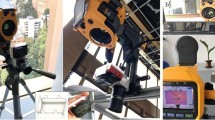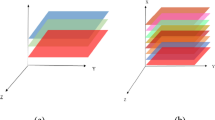Abstract
Due to the atmosphere effect, the qualities of images decrease conspicuously, practically in the visible bands, in the processing of earth observation by the satellite-borne sensors. Thus, removing the atmosphere effects has become a key step to improve the qualities of images and to retrieve the actual reflectivity of surface features. An atmospheric correction approach, called ACVSS (Atmospheric Correction based Vector Space of Spectrum), is proposed here based on the vector space of the features’ spectrum. The reflectance image of each band is retrieved first according to the radiative transfer equation, then the spectrum’s vector space is constructed using the infrared bands, and finally the residual errors of the reflectance images in the visible bands are corrected based on the pixel position in the spectrum’s vector space. The proposed methodology is verified through atmospheric correction on Landsat-7 ETM+ imagery. The experimental results show that our method is more accurate and the corrected image is more distinct, compared with those offered by current popular atmospheric correction software.
Similar content being viewed by others
References
Xu X R. Physical Theory of Remote Sensing (in Chinese). Beijing: Peking University Press, 2006. 292–383
Liang S L, Fang H L, Chen M Z. Atmospheric correction of Landsat ETM+ land surface imagery-Part I: methods. IEEE Trans Geosci Remote Sens, 2001, 39: 2490–2498
Li D R, Wang M, Hu F. Utilizing Chinese high-resolution satellite images for inspection of unauthorized constructions in Beijing. Chin Sci Bull, 2009, 54: 2524–2534
Vermote E, Tanré D, Deuzé J L, et al. Second Simulation of the Satellite Signal in the Solar Spectrum (6S) User’s Guide. UST de Lille, 59655 Villeneuve d’aseq. Laboratoire d’ Optique Atmospherique, 1997
Koutsias N, Mallinis G, Karteris M. A forward/backward principal component analysis of Landsat-7 ETM+ data to enhance the spectral signal of burnt surfaces. ISPRS J Photogr Remote Sens, 2009, 64: 37–46
Wu J, Wang D, Bauer M E. Image-based atmospheric correction of QuickBird imagery of Minnesota cropland. Remote Sens Environ, 2005, 99: 315–325
Niang A, Badran F, Moulin C, et al. Retrieval of aerosol type and optical thickness over the Mediterranean from SeaWiFS images using an automatic neural classification method. Remote Sens Environ, 2006, 100: 82–94
Tanre D, Herman M, Deschamps P Y. Influence of the background contribution upon space measurements of ground reflectance. Appl Opt, 1981, 20: 3676–3684
Keller J, Bojinski S, Prevot A S H. Simultaneous retrieval of aerosol and surface optical properties using data of the Multi-angle Imaging SpectroRadiometer (MISR). Remote Sens Environ, 2007, 107: 120–137
Kawata Y, Fukui H, Takemata K, et al. Surface reflectance ratios between visible and infrared bands of satellite images over land areas in Japan for retrieval of aerosol optical thickness. Adv Space Res, 2005, 36: 773–777
Chen C, Wu Y H, Liu Z M, et al. The ground reflectance spectrum retrieval from ETM images (in Chinese). Spectr Spec Analysis, 2007, 27: 739–743
He L M, Li X W, Yan G J, et al. Atmospheric correction for AMTIS based on BRDF loop and MODTRAN4.1 (in Chinese). J Remote Sens, 2004, 8: 389–396
Wang X Q, Yang S Z, Zhu Y H, et al. Aerosol optical thickness retrieval over land from MODIS data based on the inversion of the 6S model (in Chinese). Chin J Quantum Electronics, 2003, 20: 529–634
Ghulam A, Qin Q M, Zhu L J. 6S model based atmospheric correction of visible and near-infrared data and sensitivity analysis (in Chinese). Acta Sci Natural Univ Pekinesis, 2004, 40: 611–618
Richter R. A fast atmospheric correction algorithm applied to landsat TM images. Int J Remote Sensing, 1990, 11: 159–166
Tong Q X. Spectrum of Chinese Typical Surface Features and Its Characters Analysis (in Chinese). Beijing: Science Press, 1990. 30–150
Zhao X, Liang S H, Liu S H, et al. Improvement of dark object method in atmospheric correction of hyperspectral remotely sensed data. Sci China Ser D-Earth Sci, 2008, 51: 349–356
Wen J G, Liu Q H, Xiao Q, et al. Modeling the land surface reflectance for optical remote sensing data in rugged terrain. Sci China Ser D-Earth Sci, 2008, 51: 1169–1178
Author information
Authors and Affiliations
Corresponding author
Rights and permissions
About this article
Cite this article
Chen, C., Liu, C. & Zhang, S. Atmospheric correction of remote sensing imagery based on the surface spectrum’s vector space. Sci. China Earth Sci. 55, 1289–1296 (2012). https://doi.org/10.1007/s11430-012-4413-4
Received:
Accepted:
Published:
Issue Date:
DOI: https://doi.org/10.1007/s11430-012-4413-4




